# Azure Cognitive Search
⏲️ Est. time to complete: 30 min. ⏲️
# Here is what you will learn 🎯
In this challenge you will learn how to:
- Create an Azure Cognitive Search Service in the Portal
- Add Cognitive Skills to Azure Cognitive Search
- Integrate Azure Cognitive Search in an Node.js application
# Table Of Contents
- What is Azure Cognitive Search?
- What are the Features of Azure Cognitive Search?
- Create an Azure Search Service in the Portal
- Querying Content
- Create a Demo App
- Index Unstructured Data: Add Cognitive Skills to Azure Search
- Azure Samples
- Cleanup
# What is Azure Cognitive Search?
Azure Cognitive Search is a search-as-a-service cloud solution that gives developers APIs and tools for adding a rich search experience over private, heterogeneous content in web, mobile and enterprise applications. Your code or a tool invokes data ingestion (indexing) to create and load an index. Optionally, you can add cognitive skills to apply Artificial Intelligence processes during indexing. Doing so, you can add new information and structures useful for search and other scenarios.
Regarding your application, your code issues query requests and handles responses from Azure Cognitive Search. The search experience is defined in your client using functionality from Azure Cognitive Search, with query execution over a persisted index that you create, own, and store in your service.

# What are the Features of Azure Cognitive Search?
| Core Search | Features |
|---|---|
| Free-form text search | Full-text search (opens new window) is a primary use case for most search-based apps. Queries can be formulated using a supported syntax. Simple query syntax (opens new window) provides logical operators, phrase search operators, suffix operators, precedence operators. Lucene query syntax (opens new window) includes all operations in simple syntax, with extensions for fuzzy search, proximity search, term boosting, and regular expressions. |
| Filters and facets | Faceted navigation (opens new window) is enabled through a single query parameter. Azure Cognitive Search returns a faceted navigation structure you can use as the code behind a categories list, for self-directed filtering (for example, to filter catalog items by price-range or brand). Filters (opens new window) can be used to incorporate faceted navigation into your application's UI, enhance query formulation, and filter based on user- or developer-specified criteria. Create filters using the OData syntax. |
TIP
📝You can find more details here: Search-Filters-Facets (opens new window)
In the SCM Application, we are using the Lucene query syntax (Lucene Query Syntax Examples (opens new window)).
TIP
📝 View the full Azure Cognitive Search Feature list here: Azure Cognitive Search Feature list (opens new window)
# Create an Azure Search Service in the Portal
In this first demonstration, we are going to create a new Azure Cognitive Search instance and index the data on the "product" container that we have created during the Cosmos DB challenge.
- Let's use the same resource group that we have created for Cosmos DB challenge rg-cosmos-challenge and add a service of type Azure Cognitive Search
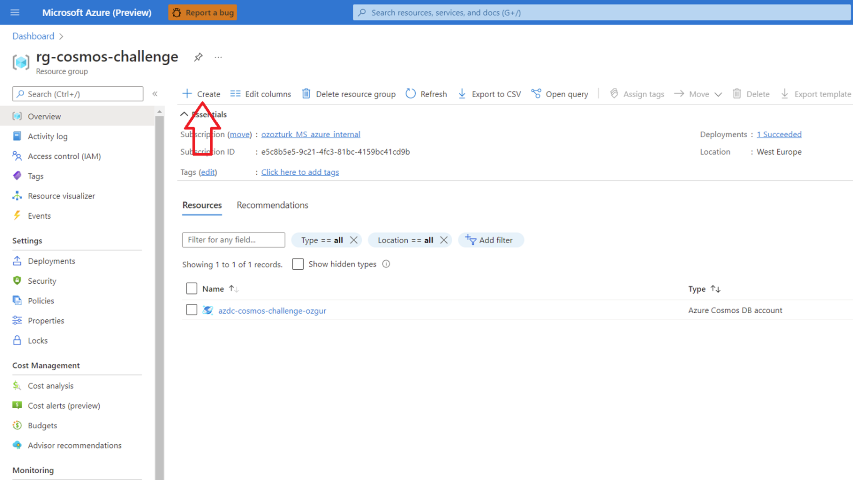
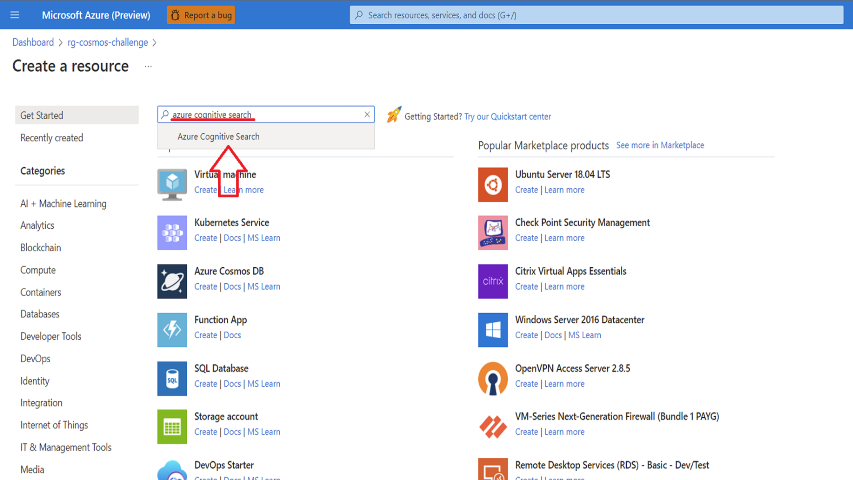
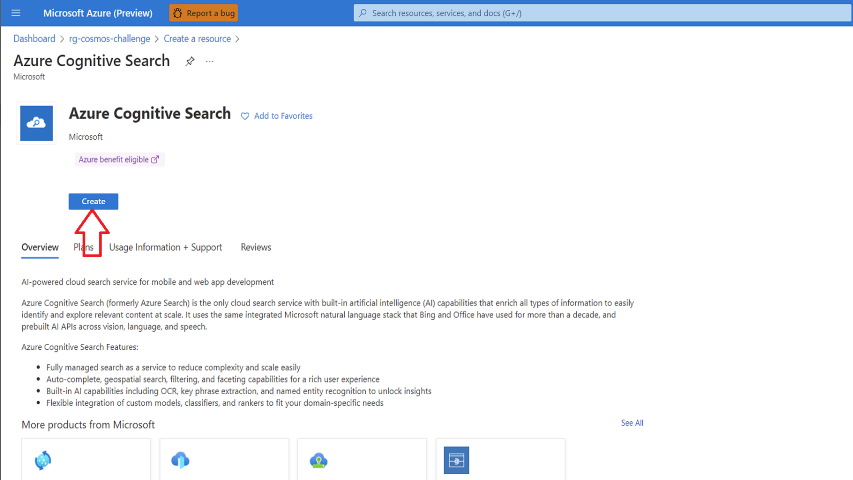
- Type azdc-cgsearch-<YOUR_SUFFIX> as "Service name" and select West Europe as "Location". For our purposes, the
Free Tierwould be sufficient.
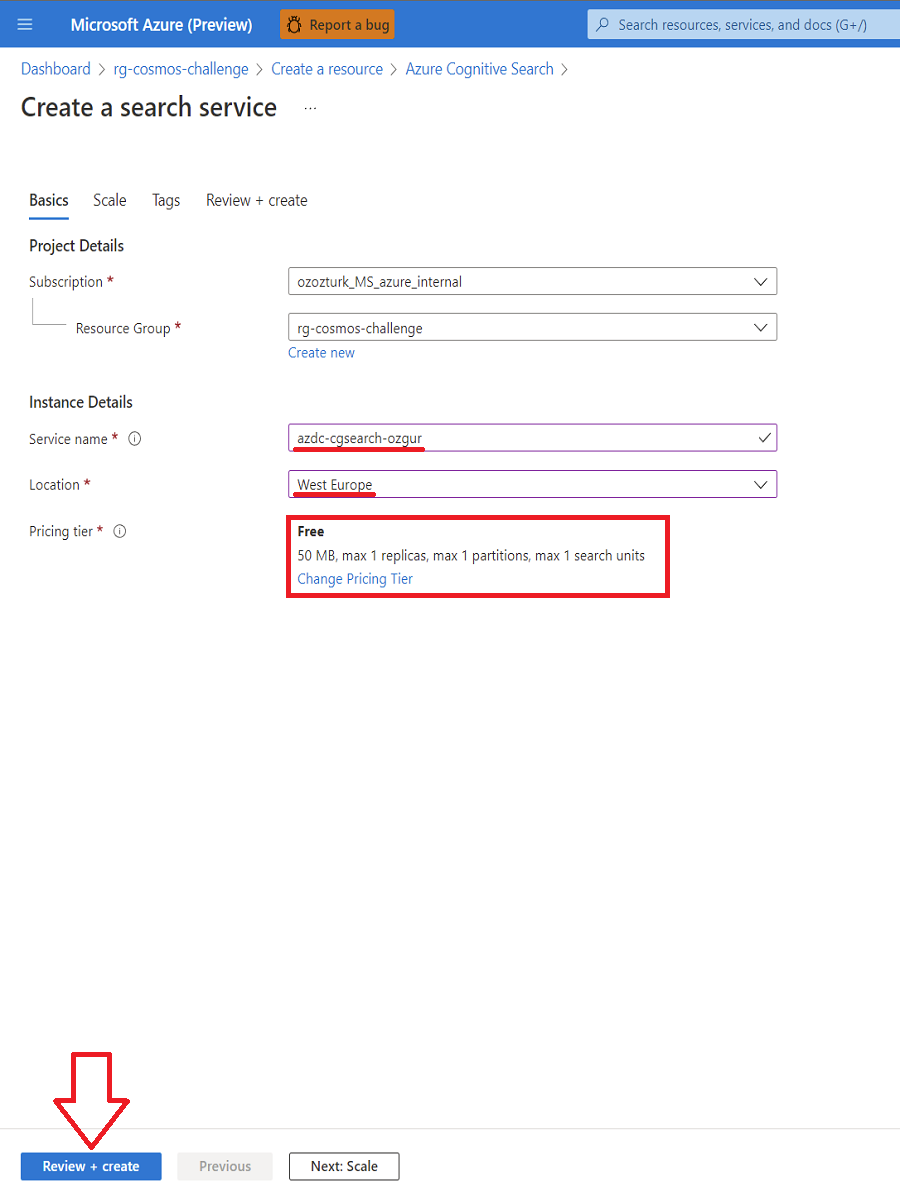
TIP
📝 However, the Free Tier does not support additional replicas, scaling and is only able to index documents with up to 32000 characters/document. If we want to index larger documents, we need to go to a bigger tier (64000 for Basic, 4m for Standard and above).
Click Create and in a few minutes your "Azure Cognitive Service" will be ready.
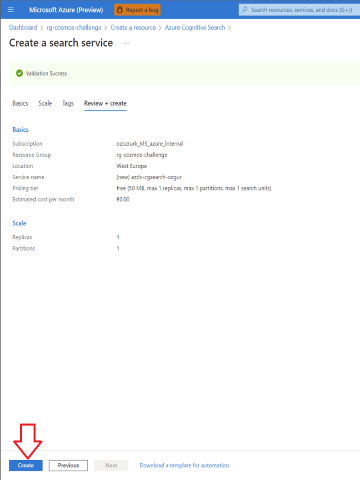
Once provisioned, our service will be reachable via https://xxxxxxx.search.windows.net
Azure Search can index (opens new window) data from a variety of sources:
- Azure SQL Database or SQL Server on an Azure virtual machine
- Azure Cosmos DB
- Azure Blob Storage
- Azure Table Storage
- Indexing CSV blobs using the Azure Search Blob indexer
- Indexing JSON blobs with Azure Search Blob indexer
In general, you can upload your data to one of the sources and let Azure Search index it from there. You can do this completely through the Azure Portal, use Storage Explorer (opens new window) or use the API/CLI.
In our case, we'll use the product data in our Cosmos DB instance.
- Open your Azure Cognitive Search instance and go to
Import Data

- Next, we need to define the
Data Sourceand choose Azure Cosmos DB as a our data source.

- On the wizard, please choose/enter the following parameters:
| Option Name | Value |
|---|---|
| Data source name | Type cosmosdb-connection |
| Connection string | Click Choose an existing connection and select azdc-cosmos-challenge-<YOUR_SUFFIX> |
| Database | AzDcdb |
| Collection | product |
keep the rest as is and click Next: Add cognitive skills (Optional)
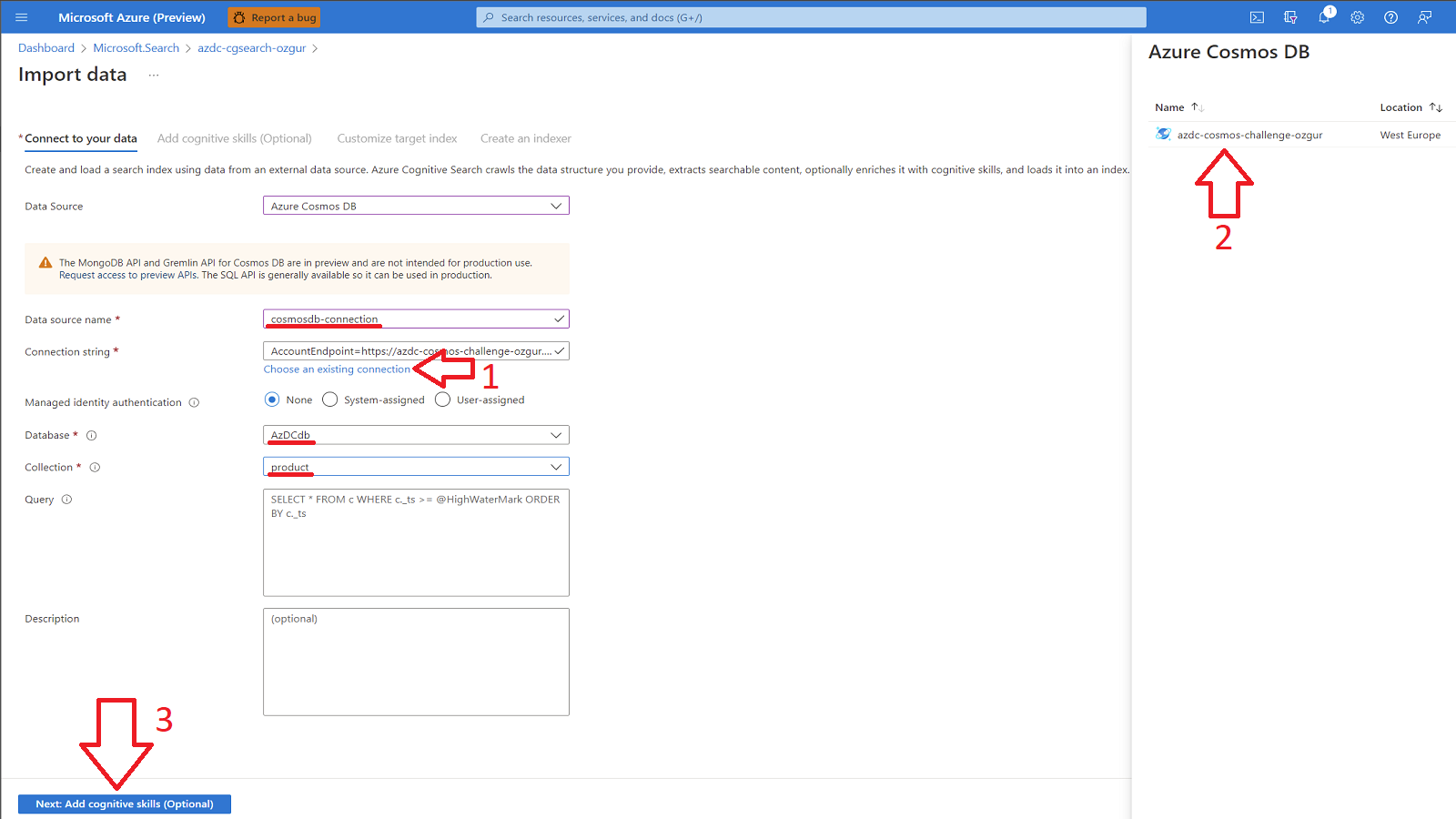
- We'll skip
Cognitive Searchfor this example.
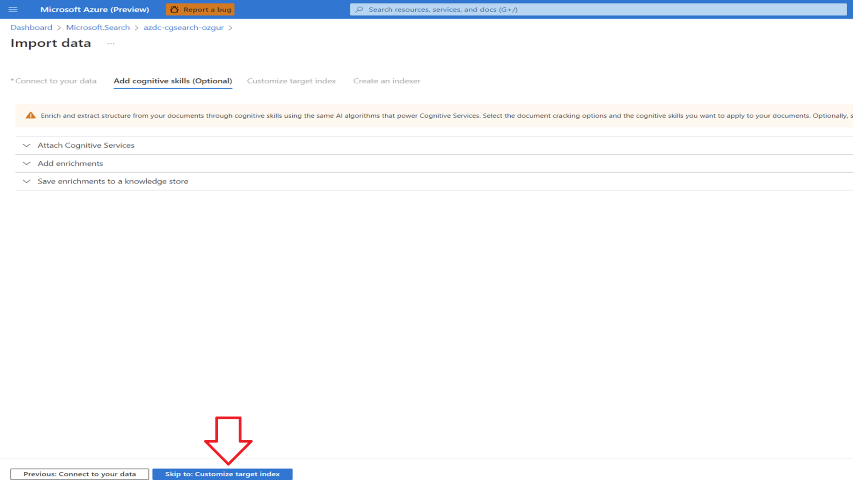
- Now let's proceed to creating an index. Minimally, an index requires a name and a fields collection; one of the fields should be marked as the document key to uniquely identify each document. Additionally, you can specify language analyzers or suggesters (typeahead/type-as-you-go services (opens new window)), if you want autocomplete or suggested queries.
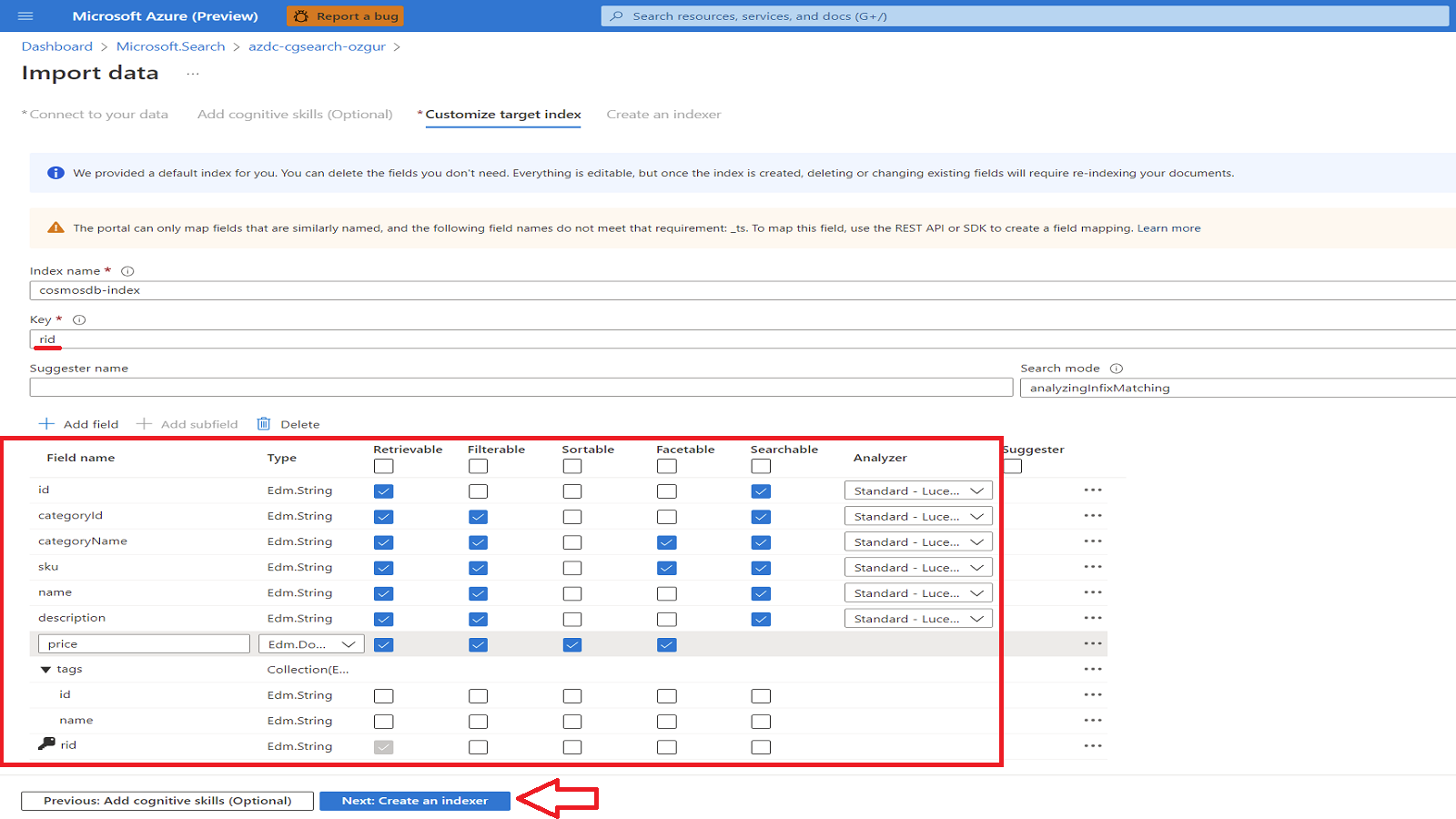
Fields have data types and attributes. The check boxes above are index attributes, controlling how the field is used.
- Retrievable means that it shows up in search results list. You can mark individual fields as off limits for search results by clearing this checkbox, for example for fields used only in filter expressions or security-related fields.
- Key is the unique document identifier. It's always a string, and it is required.
- Filterable, Sortable, and Facetable determine whether fields are used in a filter, sort, or faceted navigation structure.
- Searchable means that a field is included in full text search. Strings are searchable. Numeric fields and Boolean fields are often marked as not searchable.
TIP
📝 Storage requirements do not vary as a result of your selection. For example, if you set the Retrievable attribute on multiple fields, storage requirements do not rise.
By default, the wizard scans the data source for unique identifiers as the basis for the key field. Strings are attributed as Retrievable and Searchable. Integers are attributed as Retrievable, Filterable, Sortable, and Facetable.
Select the fields as shown above and click Next: Create an indexer
- Click Submit to create and simultaneously run the indexer. This object defines an executable process. You could put it on recurring schedule, but for now use the default option to run the indexer once, immediately.
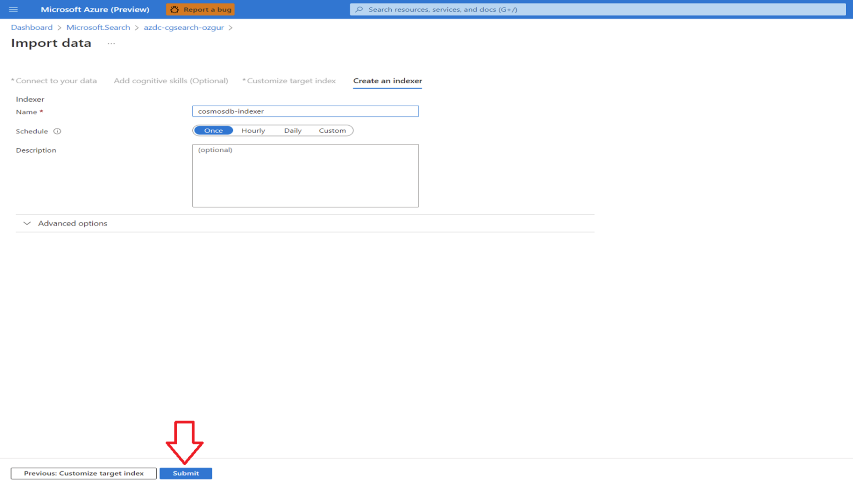
- After a minute or two, our Indexer will have indexed the Cosmos DB dataset and we should be able to query the data.

# Querying Content
Open the Search Explorer in the Azure Portal, copy the queries (see below) and get familiar with the results of the queries.
# Simple query with top N results
# String Query: search=blue
The search parameter is used to input a keyword search for full text search, in this case, returning product data for those containing blue in any searchable field in the document.
Search explorer returns results. You see that results are returned in OData notation making them easily readable by any language/other service.
Documents are composed of all fields marked as "retrievable" in the index. To view index attributes in the portal, click Fields in this index view.
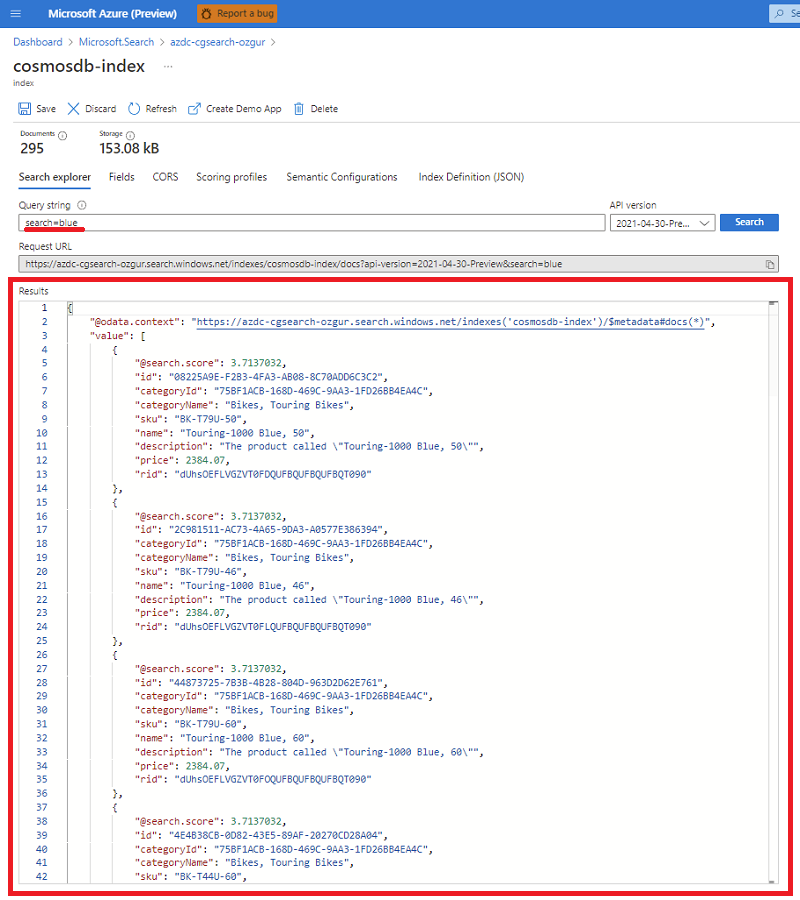
# Parameterized Query: search=blue&$count=true&$top=3
The & symbol is used to append search parameters, which can be specified in any order.
The $count=true parameter returns the total count of all documents available/found in the Azure Search index - not returned. You can verify filter queries by monitoring changes reported by $count=true. Smaller counts indicate your filter is working.
The $top=3 returns the highest ranked 3 documents out of the total ($count). By default, Azure Cognitive Search returns the first 50 best matches. You can increase or decrease the amount via $top parameter.
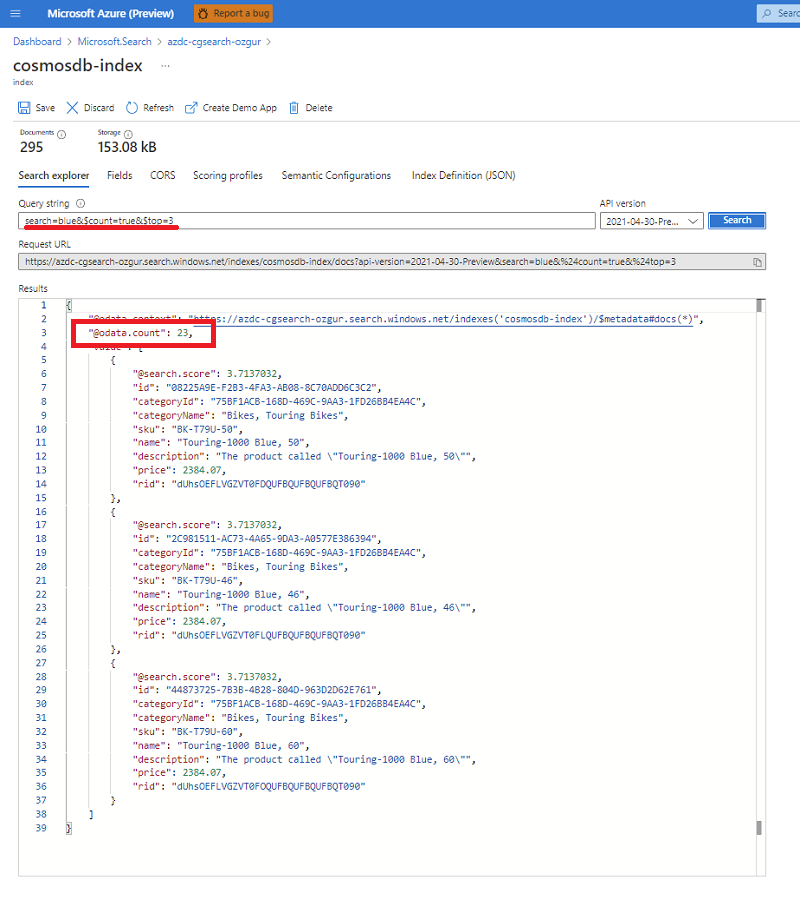
# Filter the query
Filters are included in search requests when you append the $filter parameter.
# Filtered Query: search=blue&$filter=price lt 1000&$orderby=price desc&$top=10
The $filter parameter returns results matching the criteria you provided. In this case: price less than 1000.
Filter syntax is an OData expression.
TIP
📝For more information, see Filter OData syntax (opens new window).
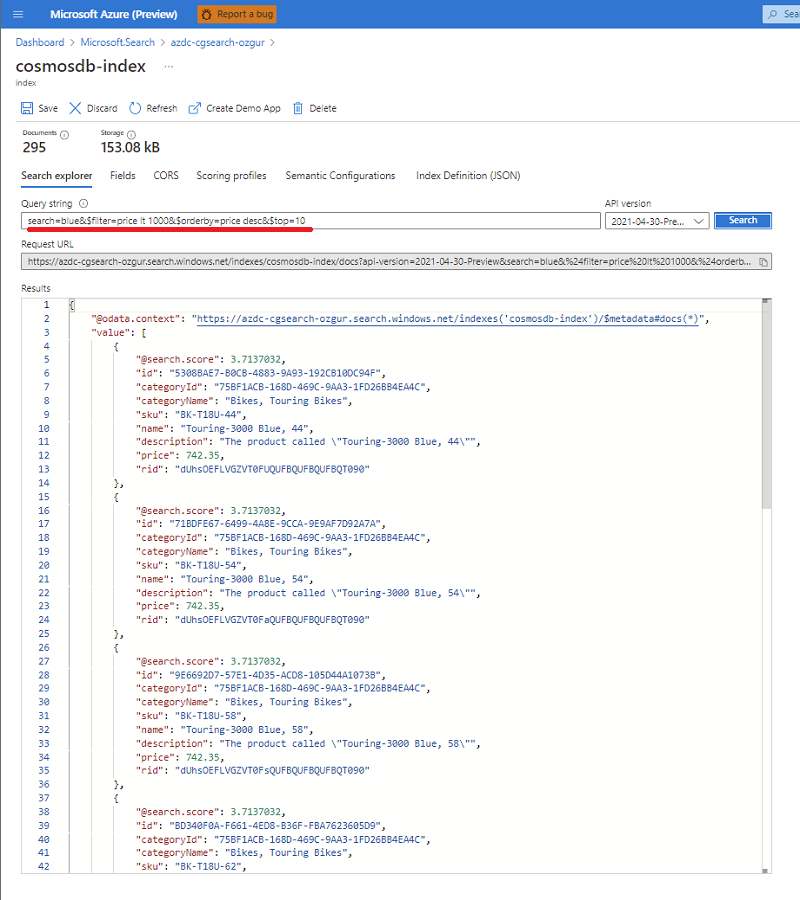
# Linguistic Analysis Query: search=blue&highlight=description
Full text search recognizes basic variations in word forms. In this case, search results contain highlighted text for "blue", for products that have that word in their searchable fields, in response to a keyword search on "blue". Different forms of the same word can appear in results because of linguistic analysis.
TIP
📝 Highlighting works by inserting HTML tags ```´´´. You have to add the corresponding CSS (or functionality), to handle the highlighting in your application.
Azure Cognitive Search supports 56 analyzers from both Lucene and Microsoft (including the same that are used in Office 365). The default used by Azure Cognitive Search is the standard Lucene analyzer.

# Try fuzzy search
By default, misspelled query terms, like bleu for "blue", fail to return matches in a typical search. The following example returns no results.
# Example (misspelled term, unhandled): search=bleu
To handle misspellings, you can use fuzzy search. Fuzzy search is enabled when you use the full Lucene query syntax, which occurs when you do two things: set queryType=full on the query, and append the ~ to the search string.

# Example (misspelled term, handled): search=bleu~&queryType=full
This example now returns documents that include matches on "blue".
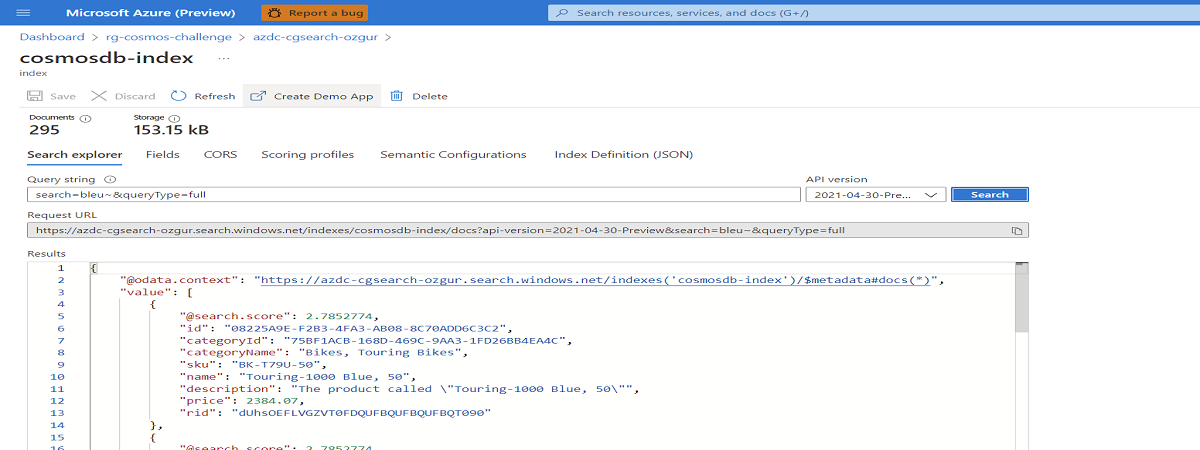
When queryType is unspecified, the default simple query parser is used. The simple query parser is faster, but if you require fuzzy search, regular expressions, proximity search or other advanced query types, you will need the full syntax.
TIP
📝 Here you find more information about the query syntax:
# Create a Demo App
Azure Cognitive Search (opens new window) allows us to create a demo application, "localhost"-style web app that runs in a browser. Depending on its configuration, the generated app is operational on first use, with a live read-only connection to a remote index. A default app can include a search bar, results area, sidebar filters, and typeahead support. The demo app can help you visualize how an index will function in a client app, but it is not intended for production scenarios.
Open your Azure Cognitive Search instance and go to Indexes. Find the index that you have created a few minutes ago and open.

Click Create demo app

Tick Enable Cors (*) tickbox and click Create Demo App
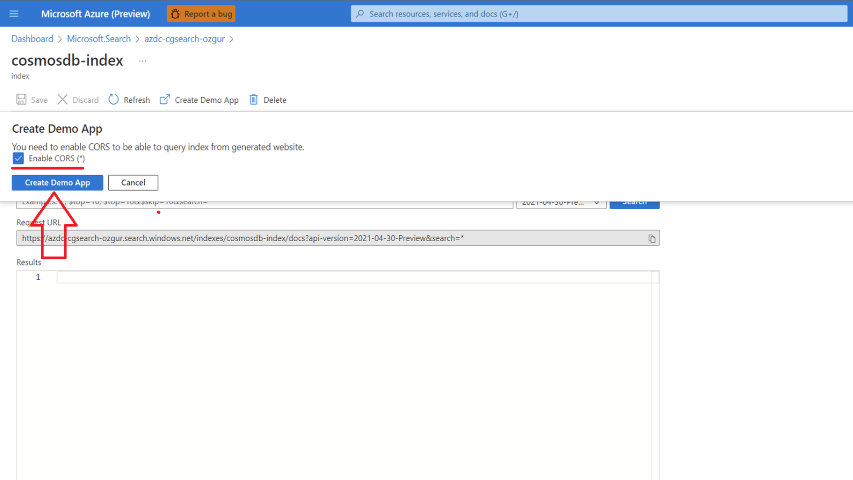
Select name as Title and description as Description. Leave rest as is and click Create Demo App

Click Download and your static web app will be downloaded.
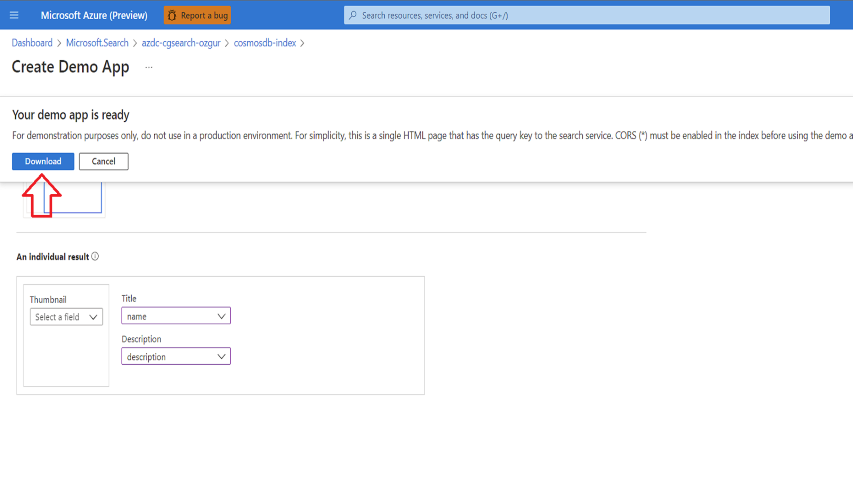
Click Open File and open downloaded html file.

Your static web app is configured and ready to use.
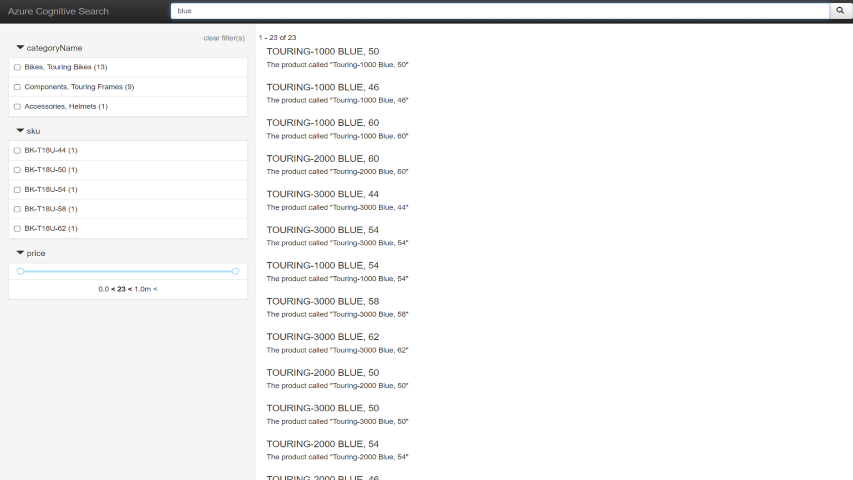
TIP
📝You can find more details here: Create-Demo-App (opens new window)
# Index unstructured data: Add Cognitive Skills to Azure Search
Azure Cognitive Search (opens new window) allows us to also index unstructured data (like images, audio etc.). More precisely, it adds capabilities for data extraction, natural language processing (NLP), and image processing to Azure Search indexing pipeline (for more see here (opens new window)). In Azure Cognitive Search, a skill set is responsible for the pipeline of the data and consists of multiple skills. Some skills have been pre-included, but it is also possible for us to write our own skills.
Let's see it in action. This time we're going to use Sample data provided by Azure Cognitive Services team.
- Go to the Azure Search Service an click on Import Data.

- Once we're done, we'll repeat the steps from before, Import Dataset, walk through the wizard, but this time, we'll configure the Cognitive Search part in the second tab.
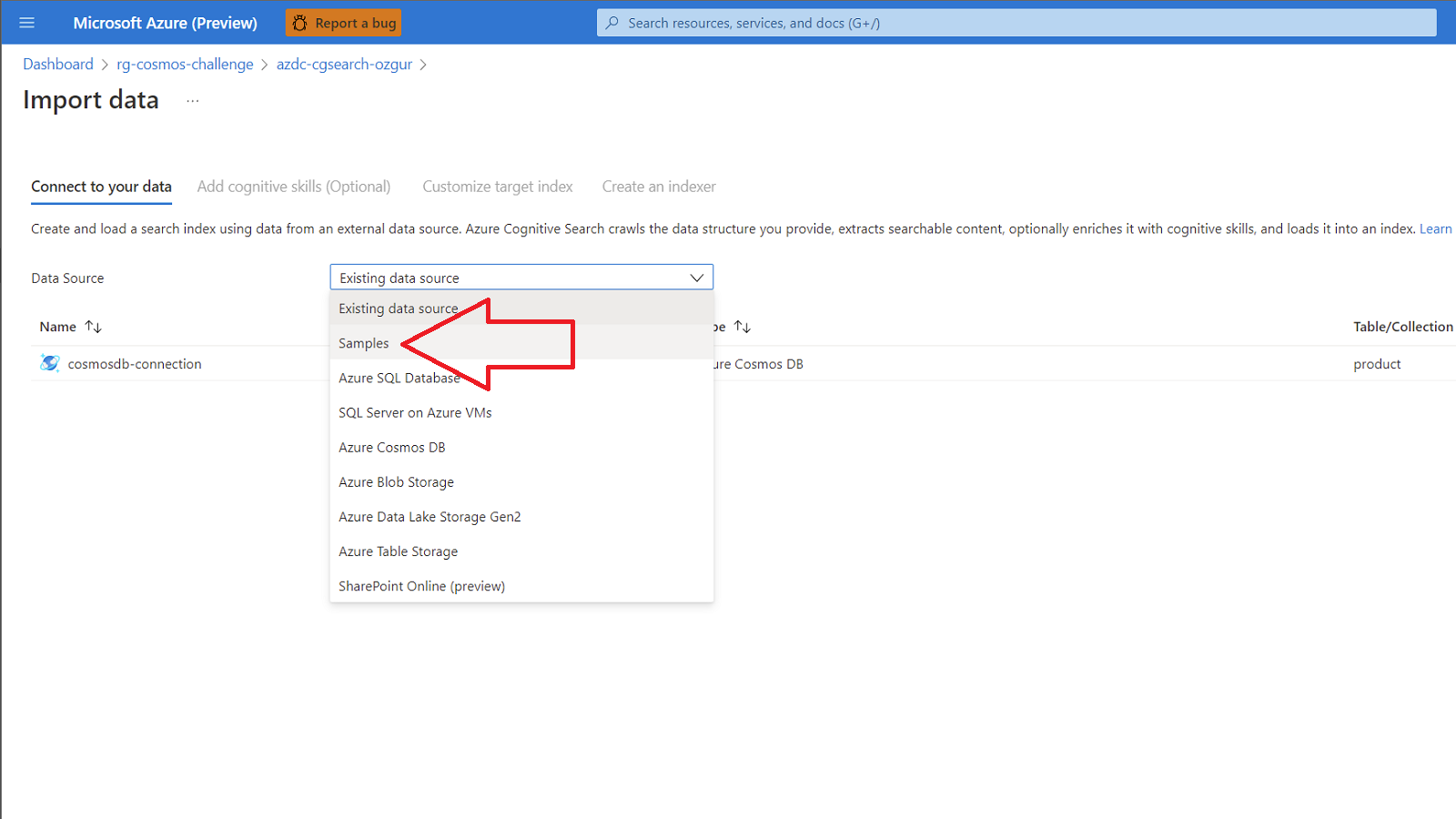
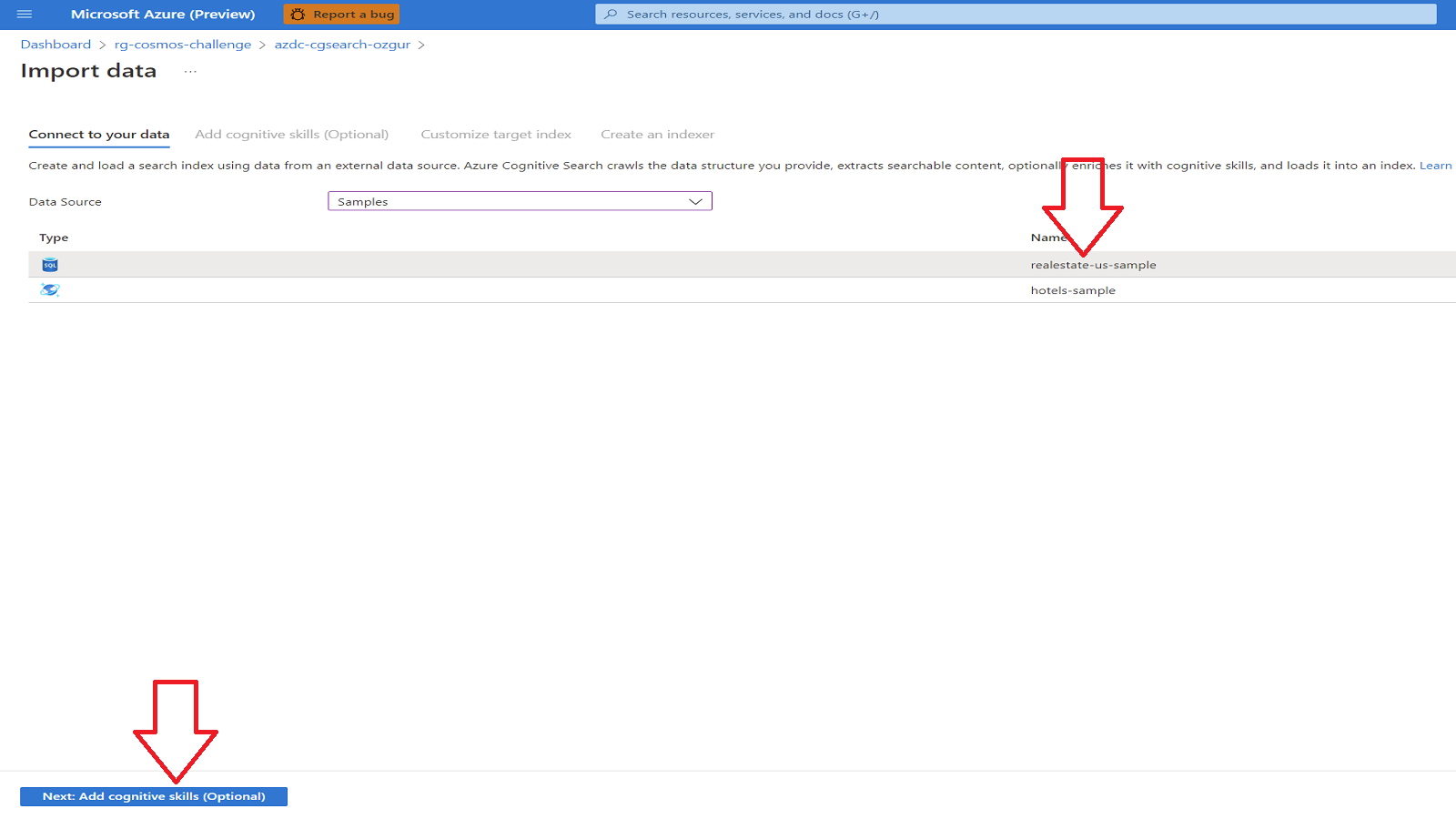
- So, we need to define the skillset. In our case, we'll enable all features under Add enrichments.
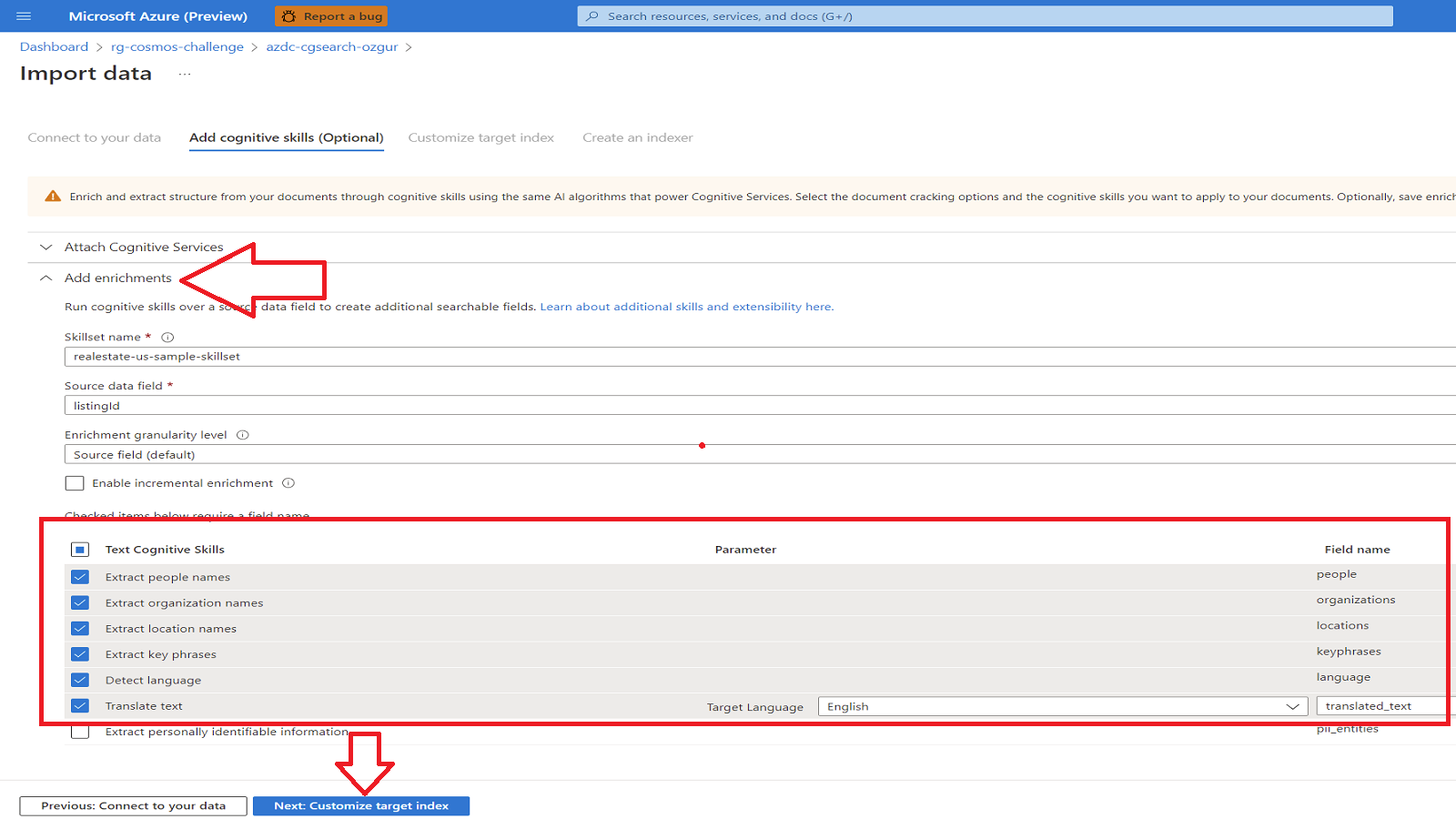
- Accept the defaults of the index. Once we have finished the next two tabs (Hit Submit to run the indexer), Azure Cognitive Search will start indexing our data (this will take a bit longer, as it needs to run image recognition, OCR, etc. on the files).
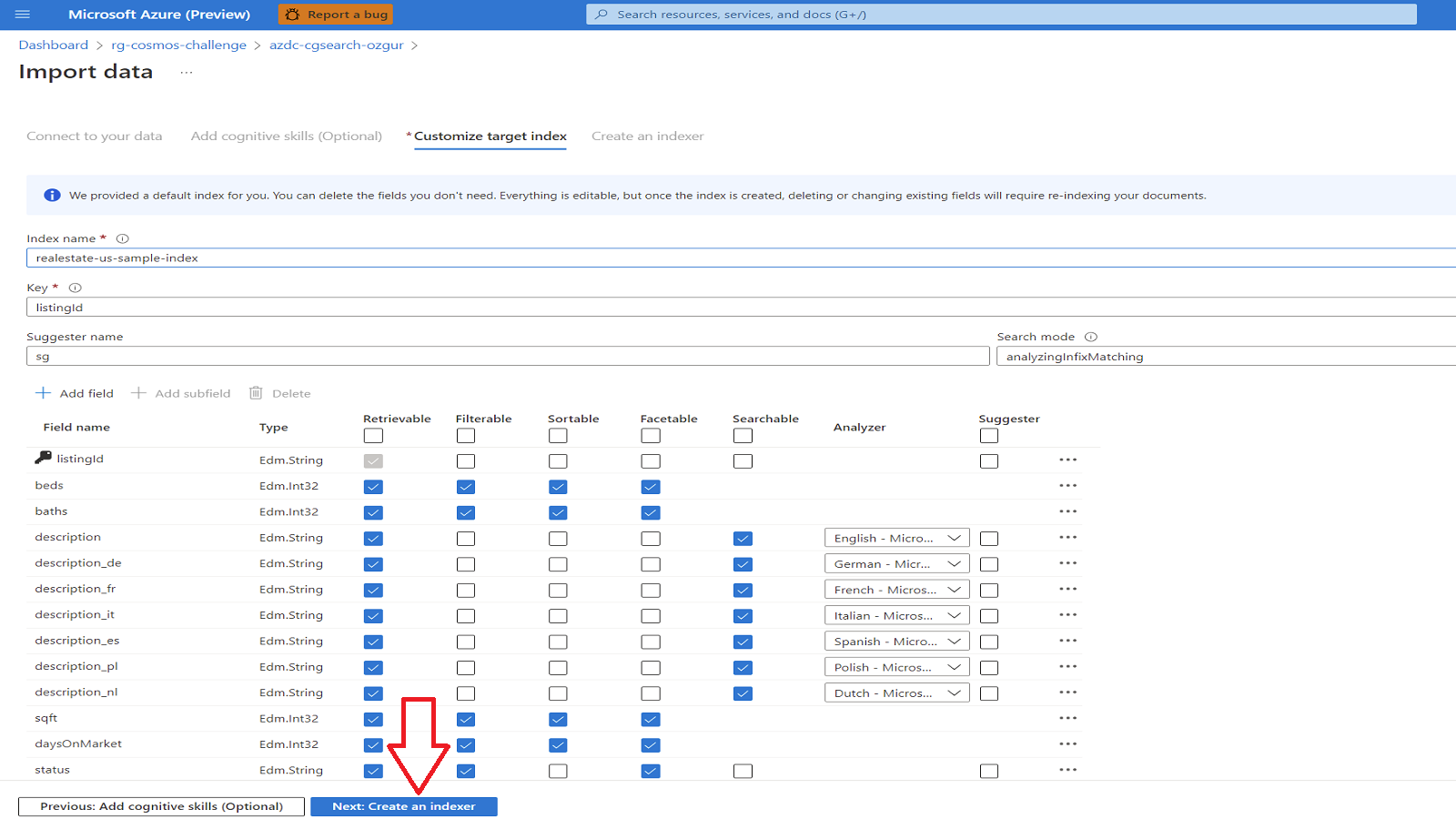
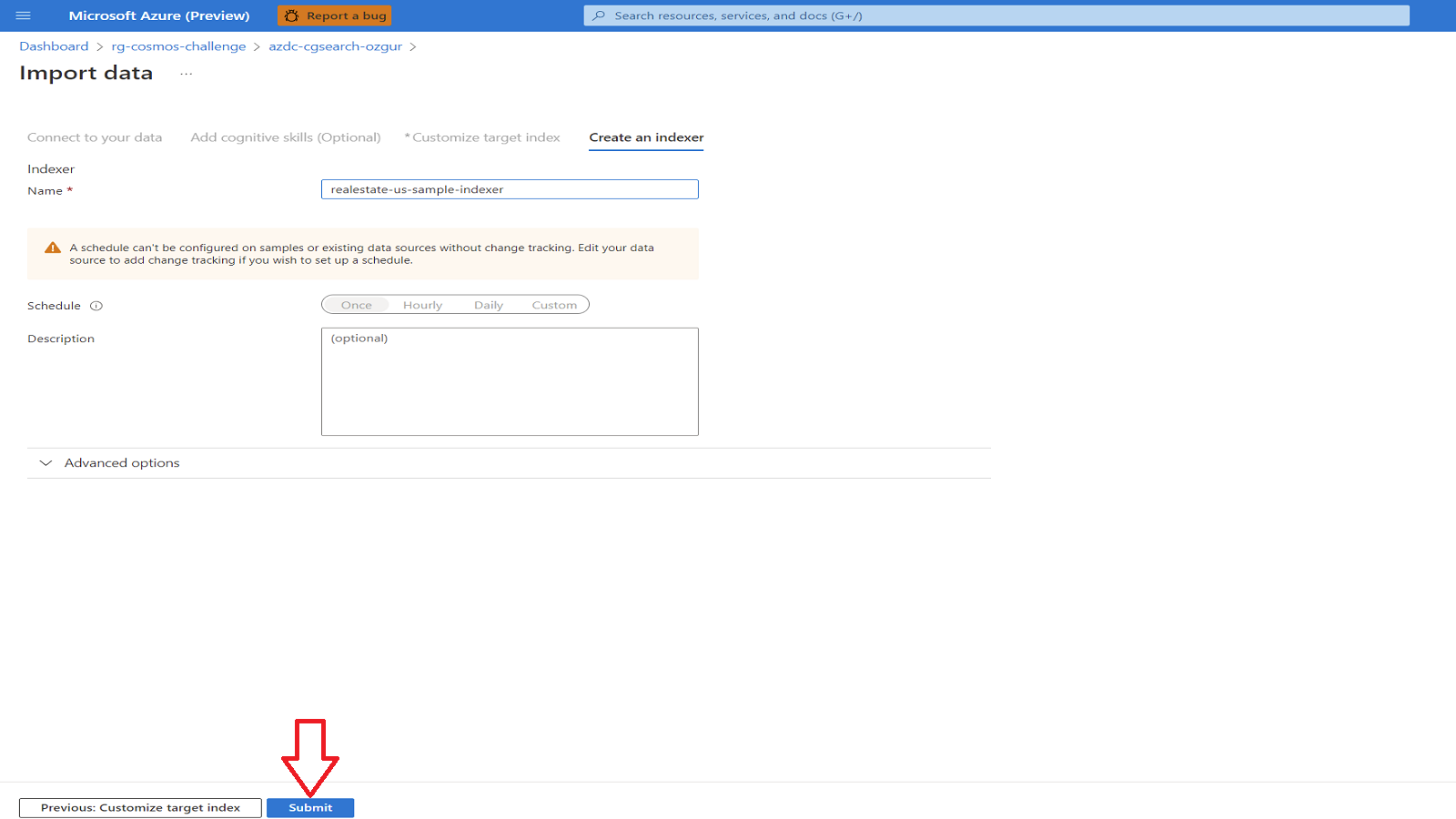
- When you select the Indexes Tab on the Overview Page in the Azure Portal and select the Realestate Index, you can use the default query and will see (as shown in the following JSON) that the cognitive skills are enabled and that the Translate Skill has a result:
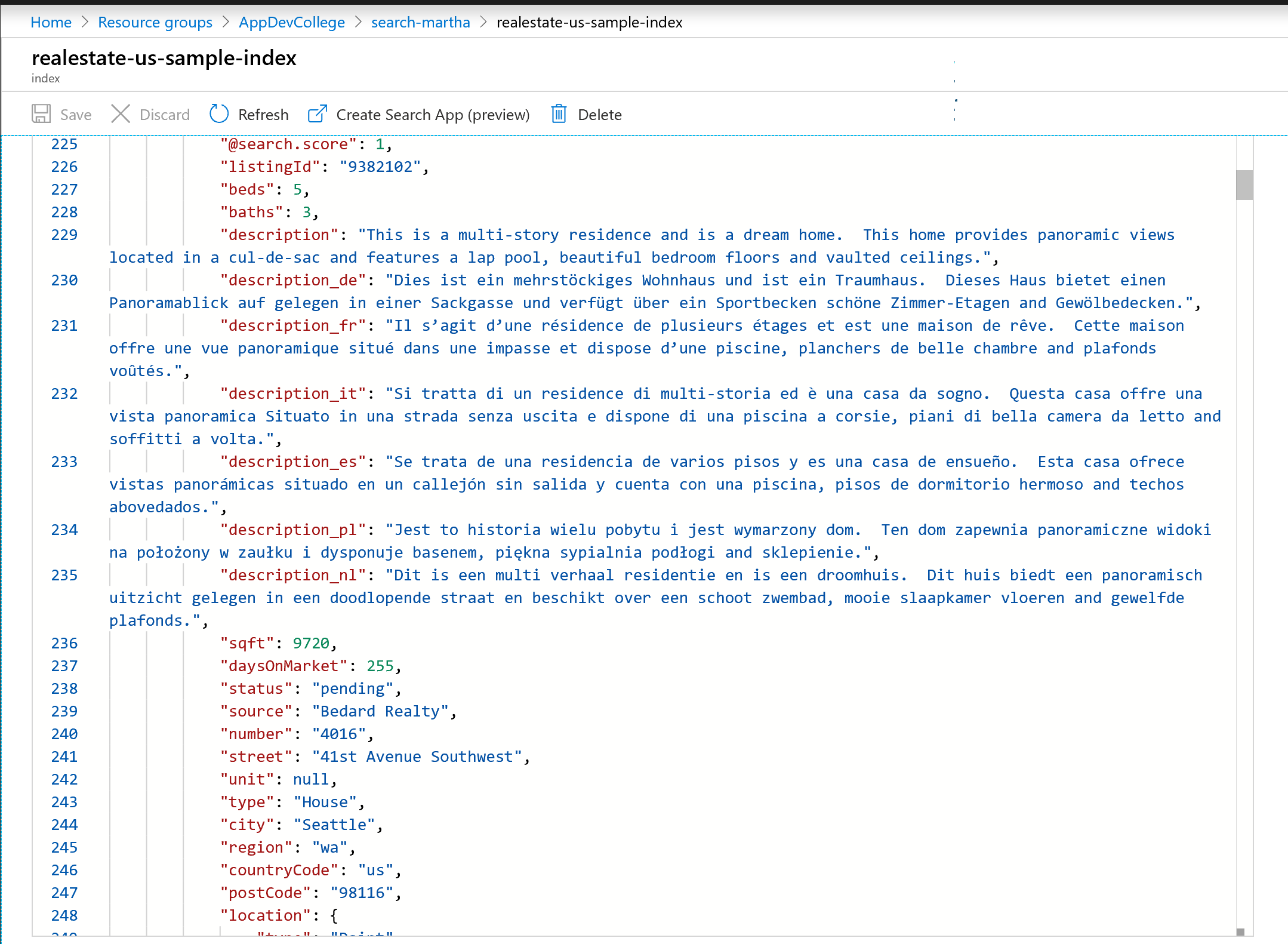

TIP
📝 We've been lazy and did everything through the portal - obviously this is not the way we want to work in the real world. Especially data ingestion and search should (and most likely needs) to be performed through the API. Here are couple of examples for basic api tasks.
# Azure Samples
Azure Cognitive Search code samples:
# Cleanup
Remove the resource group:
az group delete -n rg-cosmos-challenge